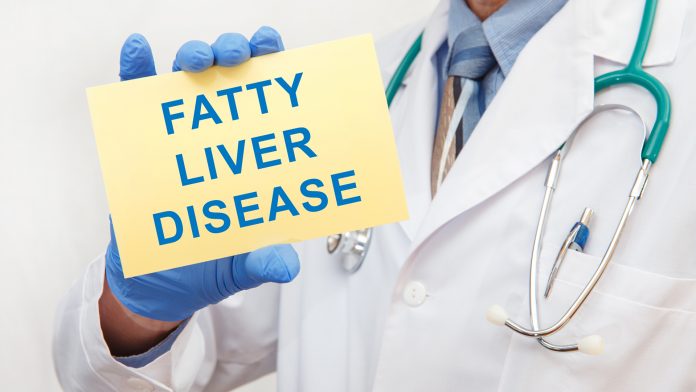
New research from the American Heart Association has estimated that one in four adults worldwide has non-alcoholic fatty liver disease (NAFLD) – a condition that is a severe risk factor for heart disease.
Non-alcoholic fatty liver disease occurs when abnormally increased amounts of fat are deposited in the liver, which can cause inflammation and scarring. Research from the American Heart Association suggests that 25% of adults globally have NAFLD, potentially putting hundreds of millions of people at risk of developing heart disease.
Barton Duell, MD, FAHA, chair of the statement writing committee and Professor of Medicine in the Knight Cardiovascular Institute and Division of Endocrinology, Diabetes, and Clinical Nutrition at Oregon Health & Science University, said: “Non-alcoholic fatty liver disease is a common condition that is often hidden or missed in routine medical care. It is important to know about the condition and treat it early because it is a risk factor for chronic liver damage and cardiovascular disease.”
The study findings are published in the Association’s journal Arteriosclerosis, Thrombosis, and Vascular Biology.
What is non-alcoholic liver disease?
There are two types of NAFLD. The first is caused when only fat is present in the liver, which is called non-alcoholic fatty liver, and the other occurs when inflammation and scarring are also present, which is called non-alcoholic steatohepatitis (NASH).
Moreover, excess alcohol consumption can cause similar fat deposits and liver dysfunction, so the term non-alcoholic liver disease is employed to distinguish between disease caused by excess alcohol, and disease without alcohol.
Non-alcoholic liver disease can remain undiagnosed for years, meaning more awareness and monitoring of the condition is essential, including access to advanced screening tools and treatments, as well as implementing lifestyle interventions to prevent and treat the disorder.
Increasing the risk of heart disease
For people with NAFLD, heart disease is the leading cause of death, with the diseases sharing many of the same risk factors, such as metabolic syndrome (elevated blood sugar and blood triglycerides, increased abdominal fat and high blood pressure), Type 2 diabetes, impaired glucose tolerance (prediabetes), and obesity. Despite this, people with non-alcoholic liver disease are at a higher risk of heart disease than people who have the same heart disease risk factors without the liver condition.
NAFLD prevention
Non-alcoholic liver disease can often be prevented by keeping a healthy body weight, exercising, eating heart-healthy foods, and managing conditions such as Type 2 diabetes and triglyceride levels in the blood. Furthermore, genetic factors influence whether a person develops the disease and if it leads to NASH, cirrhosis, or liver cancer.
Duell said: “Although healthy living can help avert NAFLD in many individuals, some may develop NAFLD despite their best efforts. At the other end of the spectrum, some individuals may have a genetic makeup that protects them from developing NAFLD despite having obesity, Type 2 diabetes, metabolic syndrome, unhealthy dietary habits or being sedentary.”
Why is non-alcoholic liver disease challenging to identify?
It is difficult to diagnose non-alcoholic liver disease as many patients generally have no symptoms, with routine blood tests sometimes not highlighting abnormalities. Moreover, elevated liver enzymes in the blood, an indicator of NADLD, may be wrongly attributed to medication side effects or recent alcohol consumption. The absence of elevated enzymes does not rule our NADLD or NASH.
However, a cutting-edge ultrasound that examines liver elasticity, fat, and stiffness can identify non-alcoholic liver disease. This is a type of non-invasive liver scan that is currently underused and can diagnose and monitor treatment in NAFLD and NASH. A liver biopsy is the most definitive method for diagnosing advanced stages of NAFLD, but it is invasive and costly.
Duell commented: “The lack of awareness of the high prevalence of NAFLD contributes to underdiagnosis. Individuals with risk factors for NAFLD warrant more careful screening.”
How lifestyle changes can treat the disease
The researchers explained that lifestyle strategies could be implemented to effectively treat non-alcoholic liver disease in its early phases, and include reducing fat intake, limiting sugar consumption, and opting for more fibre-rich vegetables and whole grains.
Moreover, the only recommended dietary intervention for NAFLD and NASH is a Mediterranean-style diet. Avoiding alcohol is also recommended, as even light alcohol intake can aggravate NAFLD and impede the liver’s ability to heal.
“Part of the good news about managing NAFLD is that healthy eating, regular exercise and weight loss or avoiding weight gain are all valuable interventions to improve health in most of us, regardless of whether we have NAFLD,” said Duell.
The investigation suggests that losing 10% of body weight can significantly reduce liver fat and improve fibrosis, with lower levels of improvement displayed with at least a 5% body weight reduction. Research also identifies that between 20 to 30 minutes of exercise per day can reduce liver fat and improve insulin sensitivity even without weight loss. Additionally, medications may be required to treat Type 2 diabetes, lower cholesterol or reduce weight, and weight loss surgery might be necessary for specific individuals.






















